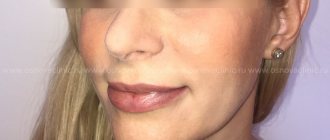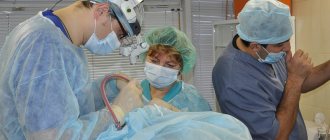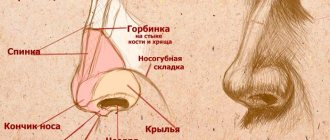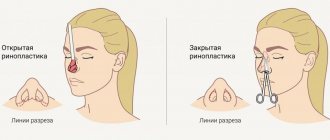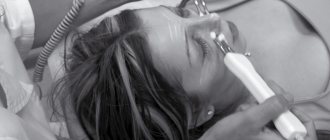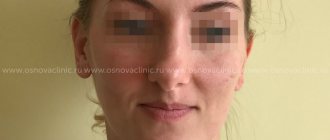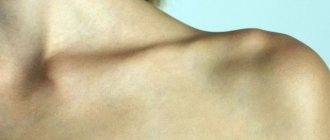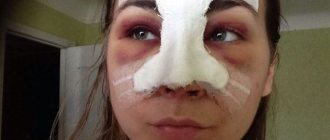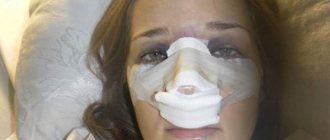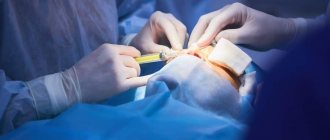For the most part, appearance plays a major role in forming an opinion about a person. A symmetrical face gives an attractive appearance, which can quickly win over the interlocutor and will please a potential partner. Even at the evolutionary level, such symmetry is due to the stability of the gene pool and adaptability to survival. Facial defects can significantly reduce a person’s self-esteem, cause a lot of complexes, and can cause a dejected mood. Flaws in appearance, due to which symmetry is reduced, can significantly affect a person’s standard of living. If men are less sensitive to external shortcomings, then the fairer sex constantly strives for perfection.
Rhinoplasty in men is primarily due to medical reasons. Defects of the nasal septum in the stronger half of humanity, in some cases, even impart a certain charm and brutality. The nose is located in the central part of the face, and therefore the curvature can significantly influence the asymmetry of the face.
Why can the nose be crooked?
A crooked nose is a definition that characterizes all types of deformities associated with deviation of the nose from the norm. This refers to the deviation of the nasal pyramid towards the facial plane. Patients with a deviated nasal septum may have congenital abnormalities or acquired injuries. The nose, as the most prominent part of the face, is most often susceptible to injury, in particular fractures. Deformation, as a result of injury, leads to changes in appearance. Curvature occurs as a result of deviation of the nasal septum. In some cases, people are born with an already deviated septum that compensates for the asymmetry. Basically, upon closer examination, almost all faces are horizontally or vertically asymmetrical, and in people whose face is smaller on one side, the nose is deviated in the opposite direction.
There is an option that when correcting the nose in this case, the face will no longer look symmetrical. That is why consultation with not one, but several plastic surgeons is necessary. In this case, most doctors will advise against surgery in order to maintain the original balance of appearance. Ideally, it is necessary to make a computer simulation of the correction result. The curvature can appear as a result of unsuccessful rhinoplasty, or due to improper growth of the nasal structure. The structural features of the nasal septum, in which there are recessed elements, can make the organ visually crooked, although the nose itself is practically not deviated from the middle of the face. In rare cases, a curvature may develop during the birth process.
Why does this happen, and is it the surgeon’s fault?
Can the surgeon foresee the outcome of the operation, as a result of which the nostrils or the bridge of the nose will become asymmetrical? Yes maybe. In case of improper muscle function.
In some patients, the levator and depressor muscles in the middle part of the face do not work symmetrically, so after rhinoplasty they can cause asymmetry. This feature is not always taken into account, or rather, it is not even always detected. To detect improper muscle function, facial tests are performed. The patient's facial expressions are assessed statically and dynamically. Unfortunately, not all doctors have such knowledge and, accordingly, do not apply it in practice.
An example of unsuccessful rhinoplasty, obvious asymmetry. The photo on the right shows the result of the correction. Photo from the website of D.R. Grishkyan. There are contraindications, specialist consultation is required
How is nose straightening surgery performed?
According to the reviews of those who have undergone surgery and the observations of doctors, correcting the shape of the nasal septum helps make the appearance more attractive. Today, rhinoplasty occupies one of the leading positions among plastic surgeries. Indications for nose correction include functional and aesthetic disorders. From a functional and cosmetic point of view, rhinoplasty is a delicate and complex operation, with a large list of contraindications, and a long rehabilitation period. That is why the risk of revision rhinoplasty is quite high. Before you decide to undergo a correction, you should weigh the pros and cons several times, consult with experienced doctors, and read real reviews of people who have already had the operation.
Curvature of the olfactory organ occurs as a result of deformation of the bones of the nasal pyramid, nasal septum, upper and lower lateral cartilages. All these defects lead to functional disorders and problems with appearance. The key reason for curvature is a strong deviation of the nasal septum from the norm. Violation of the correct shape of the nose occurs in the middle, upper part, or at the tip of the nose. To accurately determine the location of the curvature, dividing the nose into three sectors will help: the upper, middle and lower thirds. It is worth noting that a large patient of people with a deviated nasal septum often suffers from airway obstruction. The main reason for rhinoplasty in this category of patients is medical indications. Difficulty breathing can, in turn, lead to diseases of other vital organs. In the presence of a severe respiratory defect, plastic surgeons prefer to perform the operation using the open method, which allows for an external examination of the organ directly during the procedure. Correcting a crooked nose is one of the most time-consuming and unpredictable types of nose surgery. After all, after this type of operation, there is a high probability of a second and even third correction. The rate of revision rhinoplasty in this case is significantly higher than other types of surgery to correct nasal defects. This situation arises due to the complexity of the correction performed and the individual characteristics of the patients.
The main goals of surgery to correct the shape of the nose after injury:
- correction of post-traumatic deformation of the nose (restoring the shape of the nose to its pre-injury state);
- elimination of concomitant nasal defects that were present before the injury;
- changing the shape or size of the nose (at the patient’s request);
- restoration of nasal breathing.
I began performing my first rhinoplasty operations 32 years ago, mainly on patients with post-traumatic nasal deformities. These were prominent athletes of our city, boxers, hockey players, wrestlers. By that time, Anatoly Borisovich Savinkov, my father, already had solid experience, about 20 years, in correcting the shape of the nose after injury (post-traumatic deformities of the nose). It was during these operations that he passed on his experience to me, and, as he said, “trained” me. We performed operations and helped even patients who were refused in leading clinics in Moscow (where they were told that they could not be helped).
Acquired nasal deformities such as “s”-shaped, “c”-shaped or saddle nose are most often the result of trauma.
Congenital deformities of the nose also occur. The curvature can be in the cartilaginous or bony part of the nose. More often, in case of injuries, curvatures are localized at the transition point between the bone and cartilaginous parts.
Dr. Savinkov’s clinic has developed proprietary technologies for the correction of post-traumatic deformities of the nasal bones.
Rhinoplasty surgeons at Dr. Savinkov’s clinic have extensive experience in ENT surgery, in restoring nasal breathing and the shape of the nose after injury. The surgeon's experience is critical to achieving the best rhinoplasty results. In addition, it is not enough to know how to perform a surgical operation; it is very important to choose the right technology for correcting the shape of the nose, which will be effective specifically for this patient.
Patients often come to Dr. Savinkov’s clinic with a request to correct the shape of their nose after unsuccessful rhinoplasty in another plastic surgery clinic. And this is not surprising: rhinoplasty is the most difficult section of aesthetic and functional nose surgery, which is why in order to achieve good results in correcting or changing the shape of the nose, it is necessary to carefully and responsibly choose a surgeon.
Currently, Eduard Anatolyevich Savinkov is the leading surgeon of the European Clinic of Dr. Savinkov, who has more than 32 years of experience in the field of rhinoplasty. Together with his father, Anatoly Borisovich Savinkov, he stood at the origins of plastic surgery of the nose in Chelyabinsk.
E.A. Savinkov annually participates in all significant conferences on rhinosurgery in Europe and America, closely monitors all new achievements in the field of rhinoplasty, and also successfully uses in his practice proprietary technologies in rhinosurgery, piezo-rhinosurgery, endoscopic functional rhinosurgery, which allow solving the most complex problems, presented to him by patients.
Correction (change) of the shape of the nose after injury (photos before and after surgery at the Savinkov clinic)
Complexity of the operation
The progress of the operation to correct the nasal septum can be complicated by certain factors. The main factor is the presence of a certain level of memory in bone and cartilage tissue. A feature of cartilage tissue is the ability to return to its original position. The soft tissues and cartilage structure also have tension, due to which they continue to act on the nose even after rhinoplasty. These features do not allow us to guarantee a 100% effect from the operation.
Note! The structures of the nasal tissues tend to return to their original state, which can negate all the work of plastic surgeons.
In some cases, a negative result may be the result of incomplete correction of the nasal septum, due to which the nose returns to its pre-operative shape. In the presence of a congenital defect, deviation may occur as a result of the resulting asymmetry.
To correct the tip of the nose, which consists only of cartilage, it will be necessary to carry out transplantation and suturing.
Why does the nose crook to the side after rhinoplasty?
We once again draw your attention to the fact that straightening your nose one hundred percent is a very difficult and in some places almost impossible task. Even after an ideal operation, patients may experience facial asymmetry or residual organ abnormalities. It is the creation of the ideal frontal appearance that is the most difficult task for a plastic surgeon. Even a faint shadow that falls on the face can change the symmetry.
Causes of a crooked nose after rhinoplasty
There are several key reasons why the organ remains crooked or the defect is partially gone. In some cases, the cause may be swelling of the soft tissues or drift of the nasal bones. The recovery process after rhinoplasty is a rather complex and dynamic period. Immediately after the operation, the presence of edema can make the face asymmetrical, and causes fear and bewilderment in most operated patients. But, in this case, this is a temporary phenomenon that will pass in the process of proper rehabilitation. If, after a certain period, the changes in appearance have not gone away, this is a clear reason to contact the doctor who performed the operation. The intensity of how long the swelling will go away depends on the complexity of the correction performed and on the characteristics of the patient’s body. Most often, swelling goes away within a month after rhinoplasty, and after that it will be possible to evaluate the first results of the operation. The full effect of rhinoplasty can be seen in one and a half to two years. Swelling also depends on the method used for correction. When performing open correction, the swelling will be more significant. Postoperative care of the patient and strict adherence to all doctor’s recommendations during the rehabilitation period are also important.
It has been noted that in patients with thicker skin, swelling will take longer to subside.
With a properly performed operation on the nasal septum, when the nose seems to look straighter, there is a possibility of a crooked nose over time. This can be a hard blow for a patient who was already delighted with the successful outcome of the operation, only to be greatly disappointed some time later. It is swelling, in this case, that can become an obstacle to considering deviations.
The purpose of revision rhinoplasty is to correct a defect resulting from the first one, or one that was not corrected at all. Nose correction surgery involves two procedures, on both sides of the nose. The cause of asymmetry may be different degrees of healing after surgery, uneven correction of the sides. Curvature may occur due to improper excision of cartilage tissue on one side. Statistics claim that the majority of secondary corrections allow the majority of incorrectly performed operations to be corrected. Also, when performing a repeat operation to correct the nose, cartilage transplantation can be used. In some cases, it is recommended to use injections to correct visual asymmetry after rhinoplasty. Please note that such injections increase the likelihood of scarring and may jeopardize even the first nose job. Exposure to fillers will not result in a smooth nasal structure.
Differences between the first and second rhinoplasty
The first rhinoplasty is the correction of nasal defects (size or shape).
Often this is connected precisely with aesthetic views. Second rhinoplasty can solve a large number of problems that were created by the first operation, which was performed incorrectly.
The principles of the second operation are seriously different from the principles of the first, and the plastic surgeon is obliged to operate under very limited conditions. The doctor has a very serious problem due to the lack of a picture of the previous operation and lack of information. The specialist has no other choice but to work blindly, because the subcutaneous substances change greatly as a result of the operation.
In general, there are several so-called commandments of secondary rhinoplasty:
- Make an accurate diagnosis;
- Correct functional deficiencies, namely depressions, septal displacement, poor breathing, dips;
- Don’t take on something that can no longer be fixed;
- Limit surgical dissection, which has the potential to lead to even more severe complications as well as poor healing;
- To create natural expectations from the operation in the patient, one should not promise excellent results, because everyone has their own body and this is in no way possible;
- Do no harm, that is, do not make things worse.
Question and answer: Crooked nose after rhinoplasty, what to do?
Question: I had plastic surgery to correct a crooked nose. It was a congenital defect, my mother has the same nose. The operation was successful, the effect was obvious. However, about a year after rhinoplasty, the tip of the nose became crooked. I ran to my doctor, who replied that such a result was acceptable, supposedly it was even stated in the contract. I lost my contract, and the clinic refused to give them a copy, so now I don’t know what to do. I'm desperate, please help me fix the situation. Answer: Ideally, you will need a second consultation in another clinic, with another doctor. But, I have to admit that most likely, revision rhinoplasty will be needed to correct the defect. The result of unsuccessful correction could be either a surgeon’s mistake or incorrect actions during rehabilitation. But, I hasten to please you, the situation can be corrected, although you will have to go through everything again. It may not be anyone's fault and it is a feature of your fabrics.
Does non-surgical rhinoplasty help?
Nowadays, patients who want to correct asymmetry are often offered non-surgical or injection rhinoplasty. However, this method has a number of serious disadvantages:
- Correction of the nasal septum: laser and without surgery: before and after photos
- Firstly , the result does not last long
- Secondly, the use of injections can harm human health.
